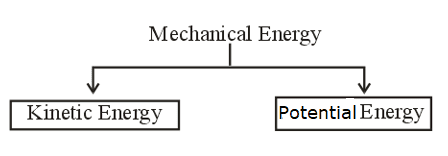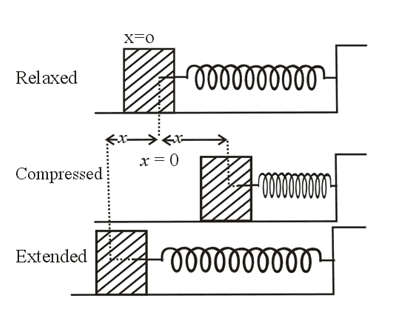Important Polynomial Questions for RRB ALP Maths Trade Exam 2018. The Maths & Physics trade will comprise 10+2 level questions. The number of questions would be 75 and the exam is qualifying in nature. In order to qualify for the exam, one needs to get at least 35% of the total marks. To help you prepare efficiently for the upcoming exam, we will be sharing Physics & Maths Trade Notes daily. Today, we are providing you with Important Work & Energy Notes.
Work & Energy Notes
Work Done by a Constant and Variable Force
Work done by a Constant Force
Work- The work done by a constant force is defined as the scalar product of force and the magnitude of displacement under the influence of force.

- Work is a scalar quantity.
Work done by a Variable Force
Let us assume that a variable force act on a particle, the variation of the force and the displacement due to the influence of force is shown below

The work done by the variable force is,
W = Area under the curve

Energy – Energy is a physical quantity which enables a system to do work. There are many forms of energy in the universe but in case of mechanical energy have two forms.

Kinetic Energy- The kinetic energy of a body is the energy possessed by the body by virtue of its motion.
Kinetic energy,  , where v is the velocity of the body
, where v is the velocity of the body
- Since both mass m and
 are always positive so KE is always positive and does not depend on the direction of motion of the body.
are always positive so KE is always positive and does not depend on the direction of motion of the body. - The relation between kinetic energy and the momentum is,
 , where p is the momentum.
, where p is the momentum. - The graph between K and p is a parabola as shown below.

- The graph between
 and p is a straight line.
and p is a straight line.

Potential Energy- The potential energy of a body is the energy possessed by the body by virtue of its position relative to other.
Potential energy, ![]() , where h is the height of the of the position possessed by the body relative to the ground.
, where h is the height of the of the position possessed by the body relative to the ground.
Work-Energy Theorem
The work-energy theorem by a constant force
It states that the change in the kinetic energy of a particle is equal to the work done on it by the net force.

Where Kf is the final kinetic energy and Ki is the initial kinetic energy.
The work-energy theorem by a variable force
Let us assume the variable force works from position xi to xf then according to the work-energy theorem the change in the kinetic energy is equals to the work done on by the variable force.

Power- The power is defined as the work done over a time period or rate of work done is known as the power.

Potential Energy of a Spring- Let a block is attached with a spring, Initially the spring its natural relaxed condition if we compressed the spring by a constant force F. Then the work done by the force is stored in the spring as the potential energy.

The potential energy of the spring 
The conservation Law of Mechanical Energy
It states that for conservative forces the sum of kinetic and potential energy at any point remains constant throughout the motion. It doesn’t depend on time.
K1 + U1 = K2 + U2 = K3 + U3 = Constant
Conservation of Other Forms of Energy
Heat Energy- The total energy of an isolated system remains constant. So, the energy can’t be created and can’t be destroyed.
Chemical Energy- The energy may change form but total energy in a chemical reaction remains constant.
Electrical Energy – The total electric charge of a system remains constant. The charge can’t be created or can’t be destroyed.
Nuclear Energy- In a nuclear reaction total mass of the reactants or starting materials must be equal to the mass of the products. So, the mass can’t be created nor destroyed.
Collision
The collision is the phenomenon in which two or more bodies come in physical contact with each other or it takes place when the path of one body is affected by the force exerted due to the other.

Elastic collision- A collision in which both momentum and kinetic energy of the system remains conserved. In this collision force involved in the interaction are of conservative in nature.
Inelastic collision- A collision in which only the momentum of the system is conserved but the kinetic energy is not conserved. In this collision, some or all of the forces involved are non-conservative in nature.
Collision in one dimension
Elastic Collision in one dimension
Consider two balls A and B of masses mA and mB are collide elastically. Let us assume that the velocity of the ball A and B before the collision is uA and uB and after the collision is vA and vB.

The velocity of the ball A after a collision, 
The velocity of the ball B after a collision, 
Inelastic Collision in one dimension
Consider two balls A and B of masses mA and mB are collide elastically. Let us assume that the velocity of the ball A and B before the collision is uA and uB (uB < uA) and after collision both the balls have same common velocity v.

The velocity of both ball after the collision, 
Collisions in two dimensions
Elastic Collision in two dimensions
Consider two balls A and B of masses ma and mb moving along X-axis with velocities ua and ub respectively. When (ub < ua) the two bodies collide. After the collision, body A moves with velocity va at an angle θ1 with X-axis and balls move with velocity vb at an angle θb with X-axis as shown in the figure.

Since the collision is elastic, kinetic energy is conserved.

According to the conservation of momentum
Initial momentum along X-axis before collision = Final momentum along X-axis after the collision
![]()
Initial momentum along Y-axis before collision = Final momentum along Y-axis after the collision

The coefficient of restitution - The ratio of the relative velocity of separation (after collision) to the relative velocity of collision (before collision).
For perfectly elastic collision, e = 1
For perfectly inelastic collision, e = 0
- A ball dropped from a height h and attaining height hn after n rebounds. Then

- A ball dropped from height h and travelling a total distance S before coming to rest. Then,
 where e is the coefficient of restitution.
where e is the coefficient of restitution.
Preparing for RRB ALP 2nd Stage? BYJU'S Exam Prep has come up with the complete test series package for upcoming Assistant Loco Pilot & Technicians 2nd Stage Exam. The first test is free. So, what are you waiting for? Check your preparation level by clicking on the below given link:
RRB ALP/ Technician 2nd Stage Part A Test Series (Free Mock Test Inside)
Thanks
Team BYJU'S Exam Prep
 , where p is the momentum.
, where p is the momentum. where e is the coefficient of restitution.
where e is the coefficient of restitution.



Comments
write a comment